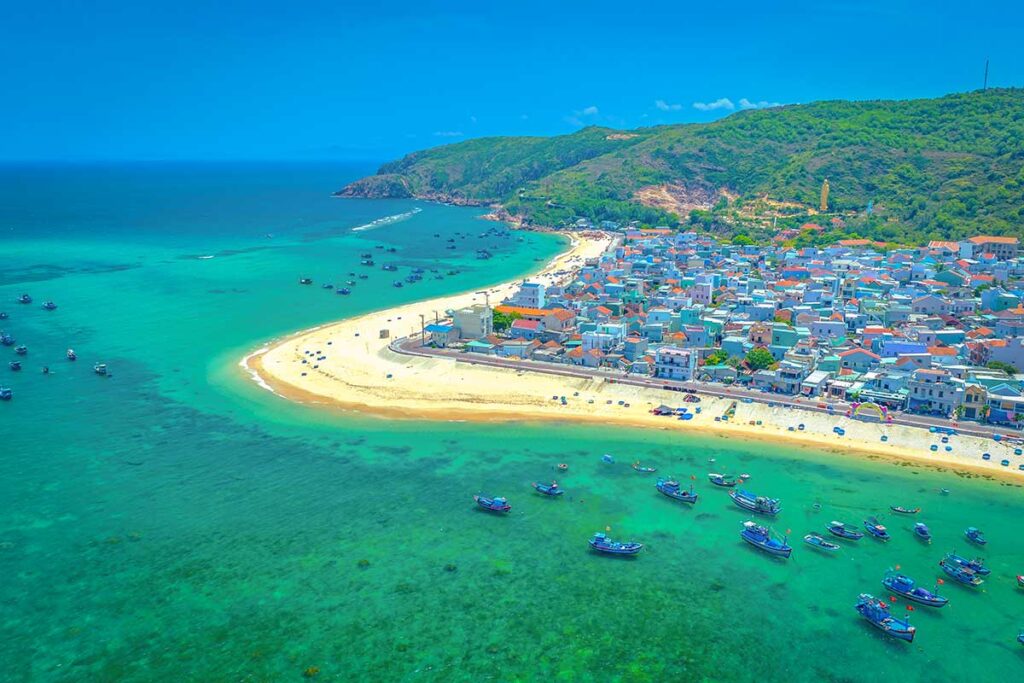What is Nhon Hai Fishing Village?
Setting & character
Nhon Hai sits on the Phuong Mai Peninsula, about half an hour’s drive from Quy Nhon. On one side you have the open sea dotted with fishing boats, and on the other side green hills rise up behind the village.
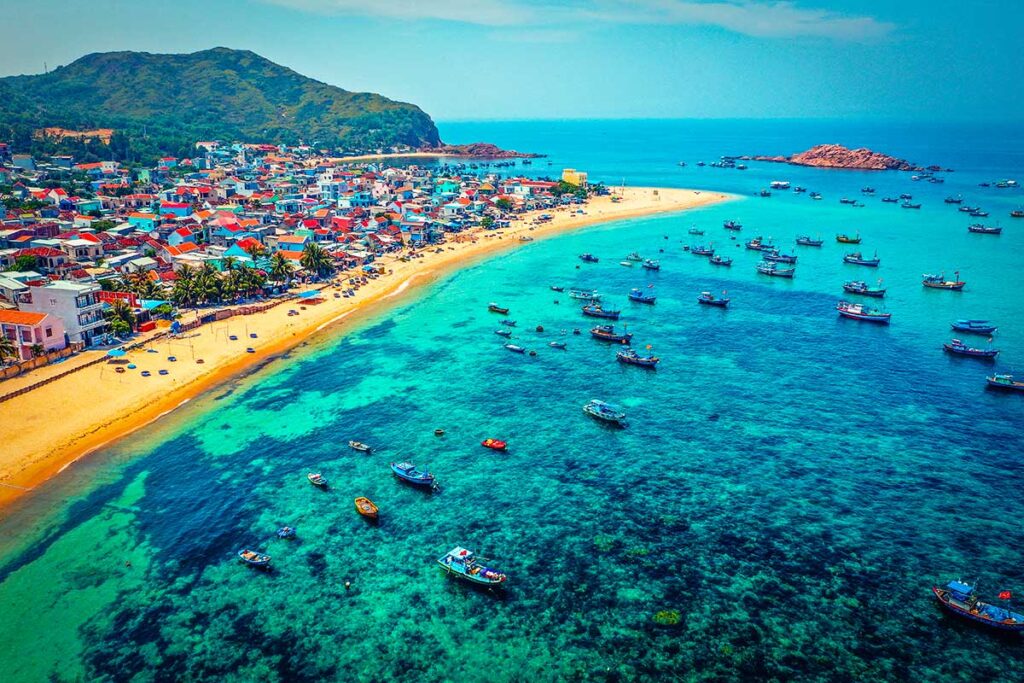
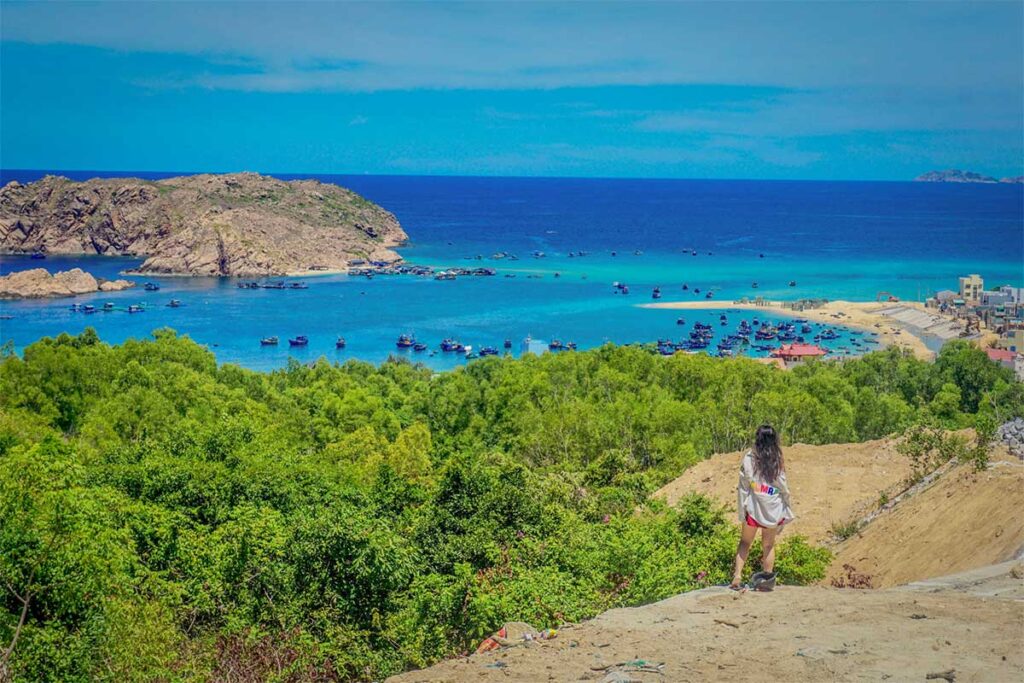
The settlement itself is a mix of narrow lanes, brightly painted homes, and the typical round basket boats lined up on the beach. It feels calm and small-scale, with just enough life and color to keep it interesting.
Village life & light tourism
Life here still revolves around fishing. Early in the morning you see boats returning, families sorting their catch, and kids playing barefoot on the sand.
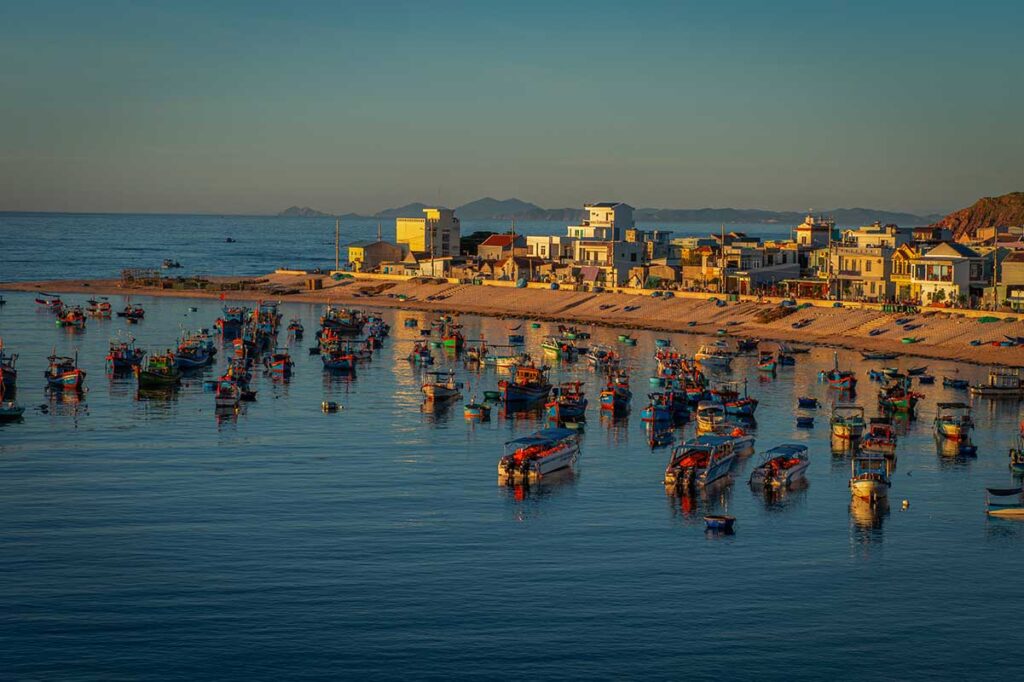

Small seafood stalls and a few noodle shops cater mostly to locals, though visitors are welcomed without fuss. Tourism has arrived but in a very light way—think homestays, basic seafood restaurants, and a couple of places renting snorkel gear. It’s not a polished resort area, and that’s part of its appeal if you want something simple and local.
Things to do at Nhon Hai Fishing Village
1. Wander the village & viewpoints
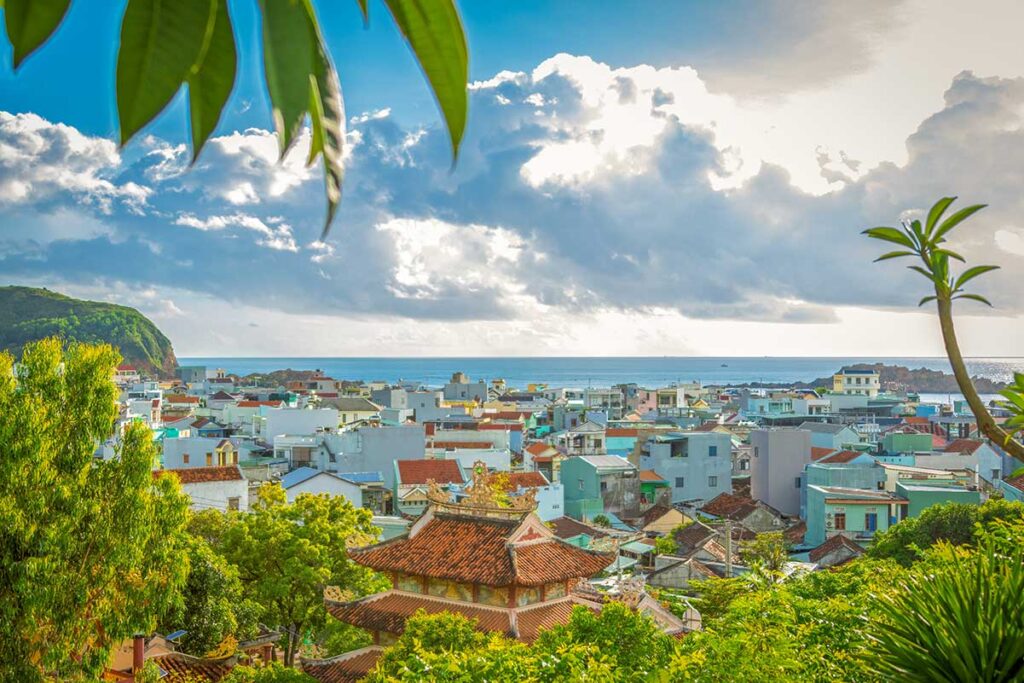
The village itself is worth a slow walk. Narrow lanes run between simple houses, and you’ll often see fishing nets being mended outside. Down by the small harbor, round basket boats line the sand and larger fishing boats bob offshore.
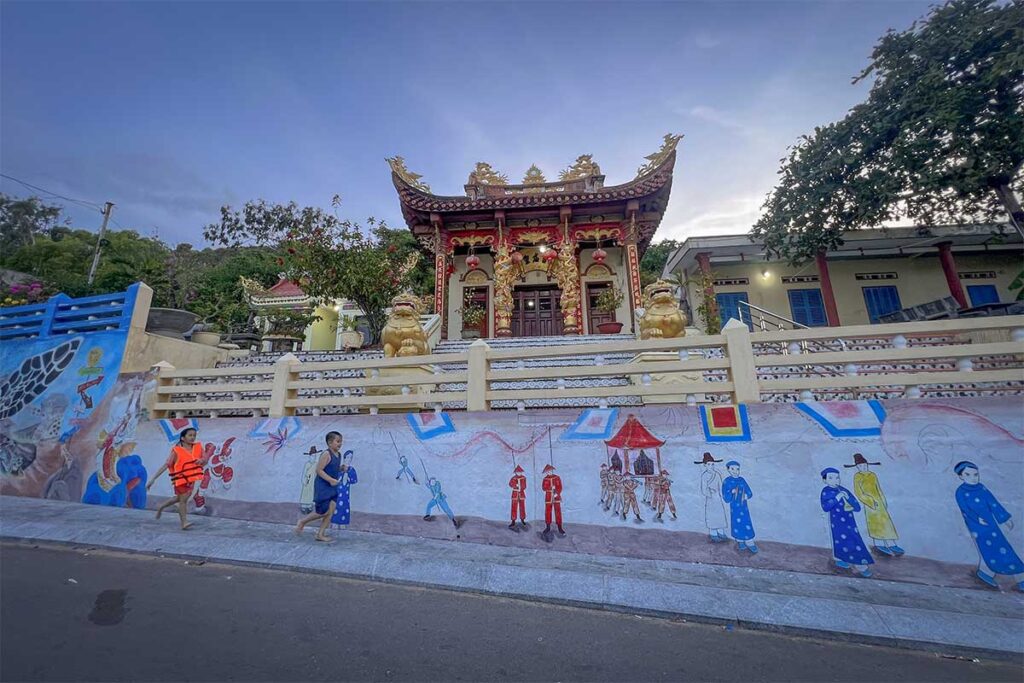

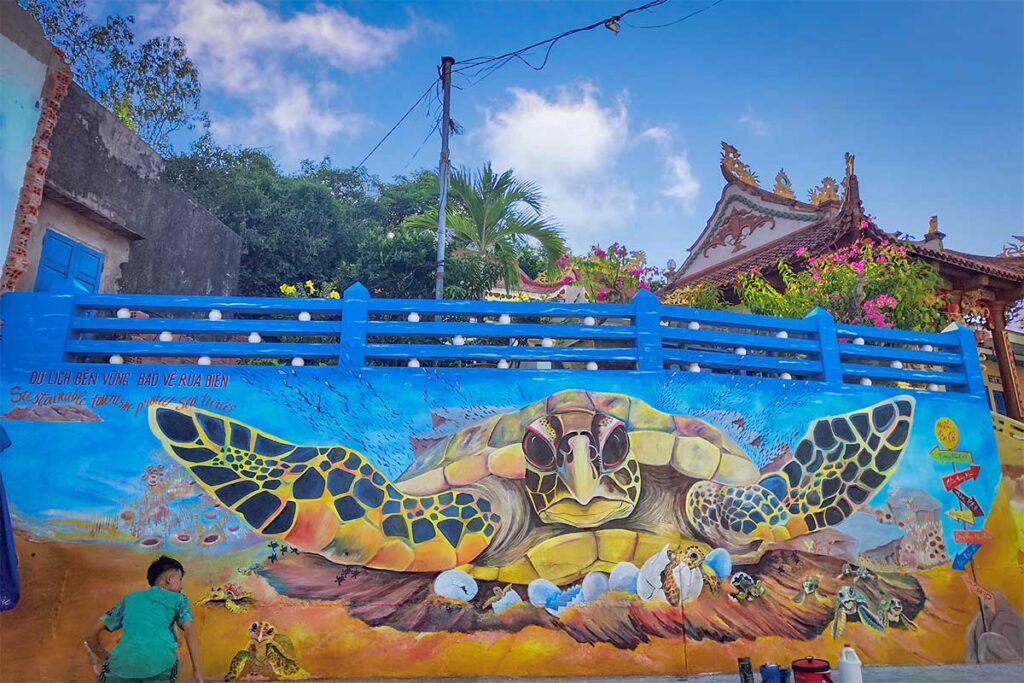
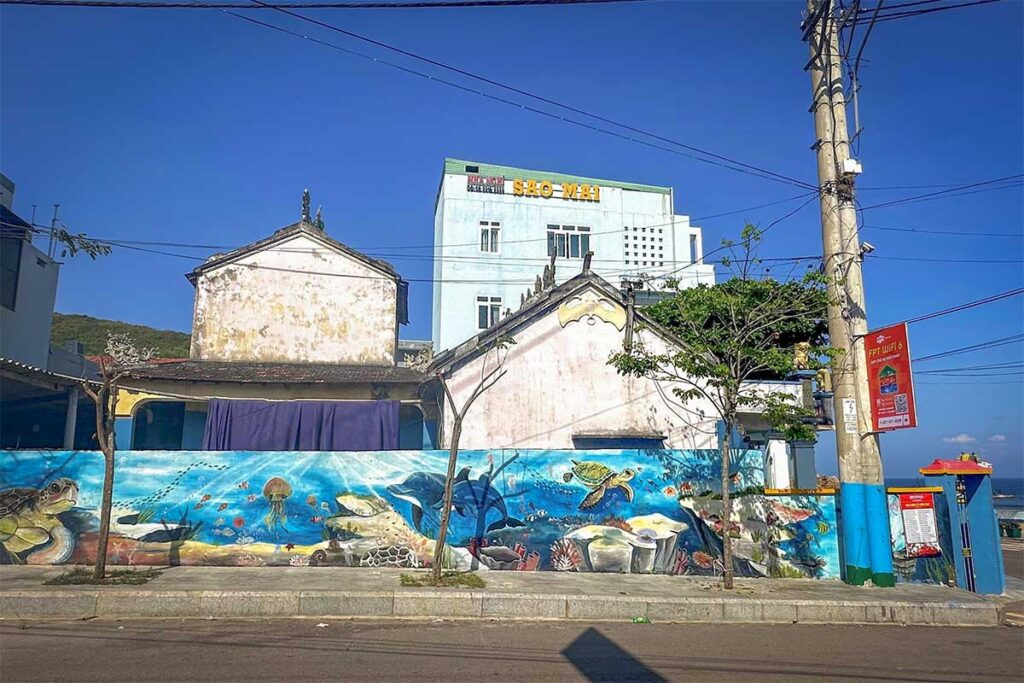
There are a few small temples tucked away, usually quiet, where you might catch a glimpse of daily offerings. For photos, the best views are along the beach where the colorful fleet sits against the backdrop of green hills and offshore islands.
2. Swim & relax at Nhon Hai Beach

The beach stretches in front of the village with golden sand and clear, calm water on most dry-season days. It’s good for swimming, and you’ll usually find children splashing about in the afternoons.
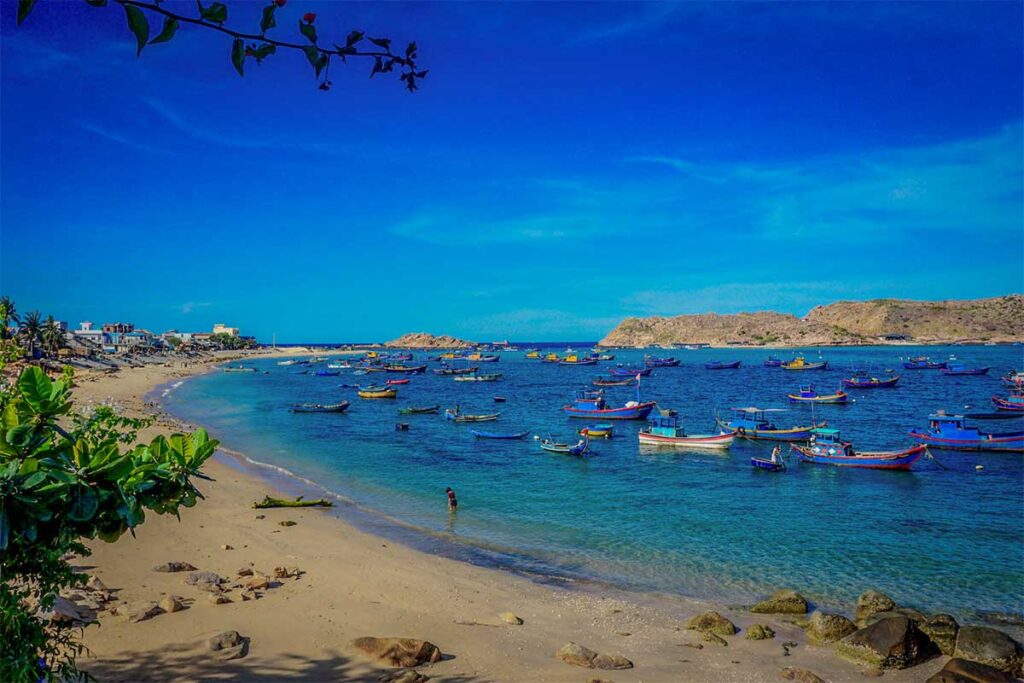
Shade is limited, so bring a hat or sit near one of the small cafés or homestays that set up umbrellas for their guests. The atmosphere is relaxed—more about unwinding than a line-up of services.
3. Snorkeling from shore (no boat needed)
One of the highlights of Nhon Hai is that you can snorkel directly from the beach. The best spot is at the far right end near the rocky headland, around the CocoCamp area. On calm days, the water is clear enough to see coral and small fish without needing a boat. Some homestays lend out basic masks, but not all, so it’s best to bring your own. Always keep an eye on the currents and avoid venturing too far alone.
4. Boat trip to Hon Kho Island


Hon Kho is a small island just offshore, reached in about 5–15 minutes by speedboat or coracle. Local boat owners and homestays can arrange the trip, with prices usually in the range of 150,000–250,000 VND per person for a round trip.
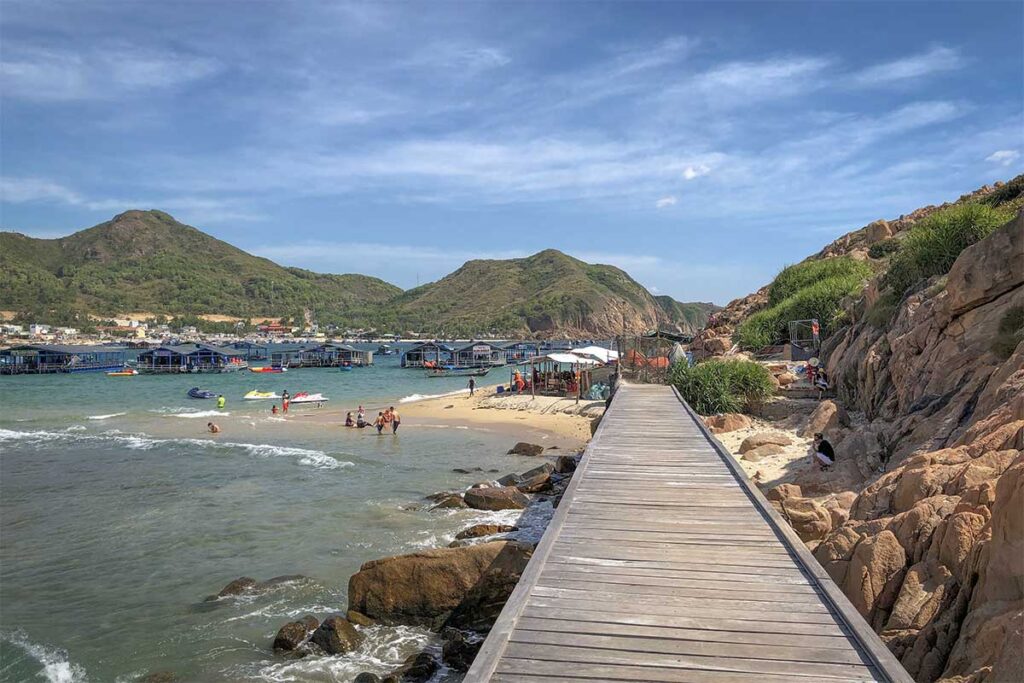
The island is popular for snorkeling around the coral gardens, simple seafood meals, and a short climb up the rocks for wide coastal views. There’s also a wooden boardwalk built along the shoreline that has become a favorite spot for photos. It can get busy in summer weekends, but on weekdays it often feels quiet.
5. Low-key water fun
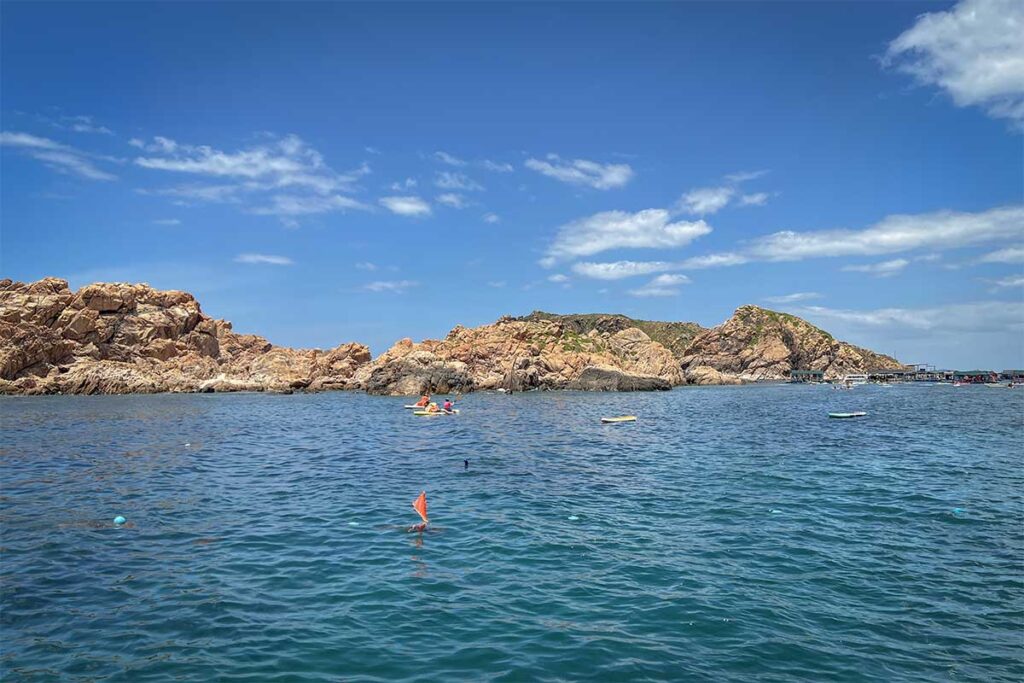
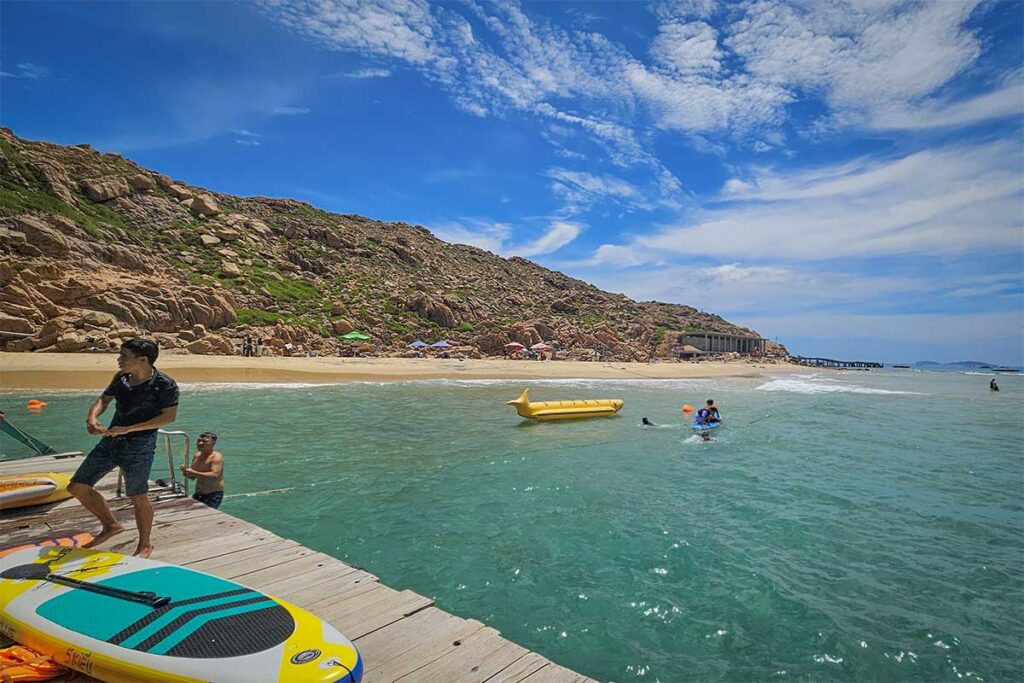
Beyond swimming and snorkeling, there are chances to rent a kayak or paddleboard. On some days you’ll also find jet skis and banana boats operating on the left side of the beach. They don’t usually dominate the scene, so if you prefer quiet water just head to the opposite side where things stay calmer.
6. Eat local: banh xeo muc & simple seafood
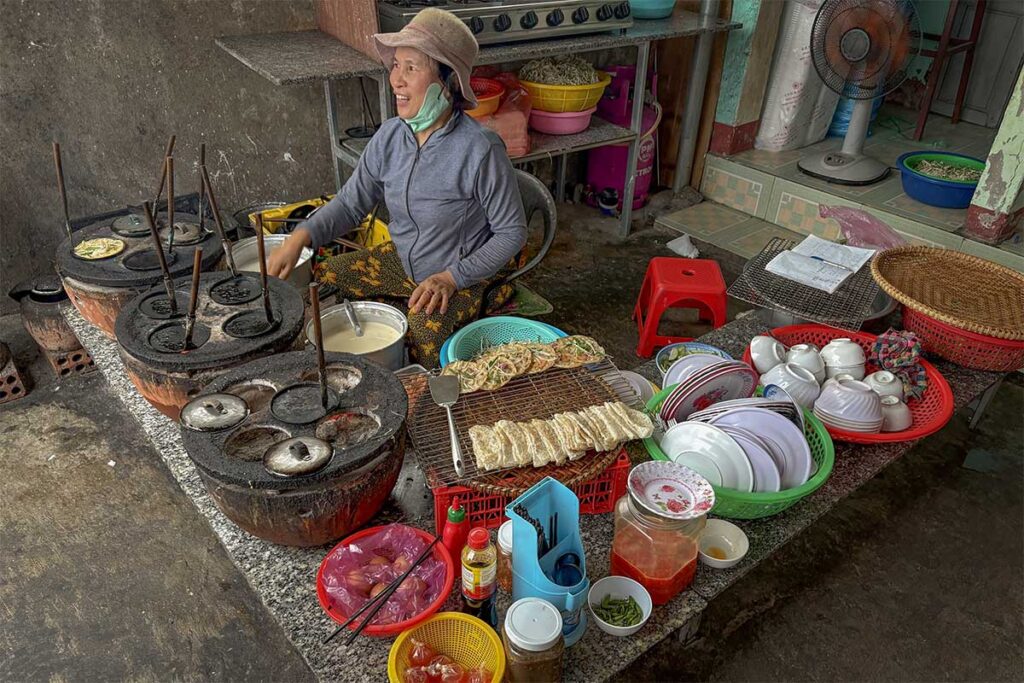
Nhon Hai’s food highlight is banh xeo muc—crispy rice pancakes with fresh squid cooked in small pans. They’re sold by women along the shore, often in the afternoons and evenings. Ordering is easy: just point to the pancakes and choose between plain or squid-topped. Expect a slightly briny taste since the squid is cooked with its ink, something locals enjoy. Besides that, you’ll find simple seafood meals—grilled fish, clams, shrimp—often cooked right beside the beach, fresh and inexpensive.
How to get there
Where is Nhon Hai?
Nhon Hai lies on the Phuong Mai Peninsula, about 20 kilometers northeast of Quy Nhon city. To reach it, you cross the long Thi Nai Bridge over the lagoon, then follow quiet coastal roads that wind past the Nhon Hoi economic zone before reaching the fishing village. The setting is scenic, with sea on one side and hills on the other, making the drive itself part of the experience.
Taxi or Grab
Taking a taxi or Grab from Quy Nhon is straightforward and takes around 30 minutes. The challenge is usually the return trip—drivers are not always available in Nhon Hai, especially in the late afternoon or evening. A practical option is to ask the driver to wait for you while you explore, which most are willing to do for an agreed return fare.
Private car with driver (day loop)
Hiring a private car with driver is the most convenient way to combine Nhon Hai with nearby attractions. A typical day loop might include stops at Eo Gio, Ky Co Beach, and the Phuong Mai sand dunes, with Nhon Hai as a quieter contrast. Prices are usually fixed for the whole itinerary, and the driver waits at each stop, so you don’t need to worry about finding transport between places.
Motorbike
For independent travelers, renting a motorbike in Quy Nhon is a popular choice. The ride to Nhon Hai is relatively easy, with light traffic compared to major Vietnamese highways. You’ll pass through villages and open stretches of coastline, which makes the trip enjoyable. Officially, foreign riders need a valid motorbike license from home along with an International Driving Permit (IDP), though in practice this is often overlooked by rental shops. If you’re not comfortable on a bike, stick with a car or taxi.
Where to stay
Spending the night in Nhon Hai makes sense if you want a slow beach day, time for photography in the soft morning or evening light, or an early start for a boat to Hon Kho. Facilities are limited compared to Quy Nhon city, but that’s part of the charm if you’re after a simple fishing village experience.
Nhon Hai Beach Hotel / hostel-style stays
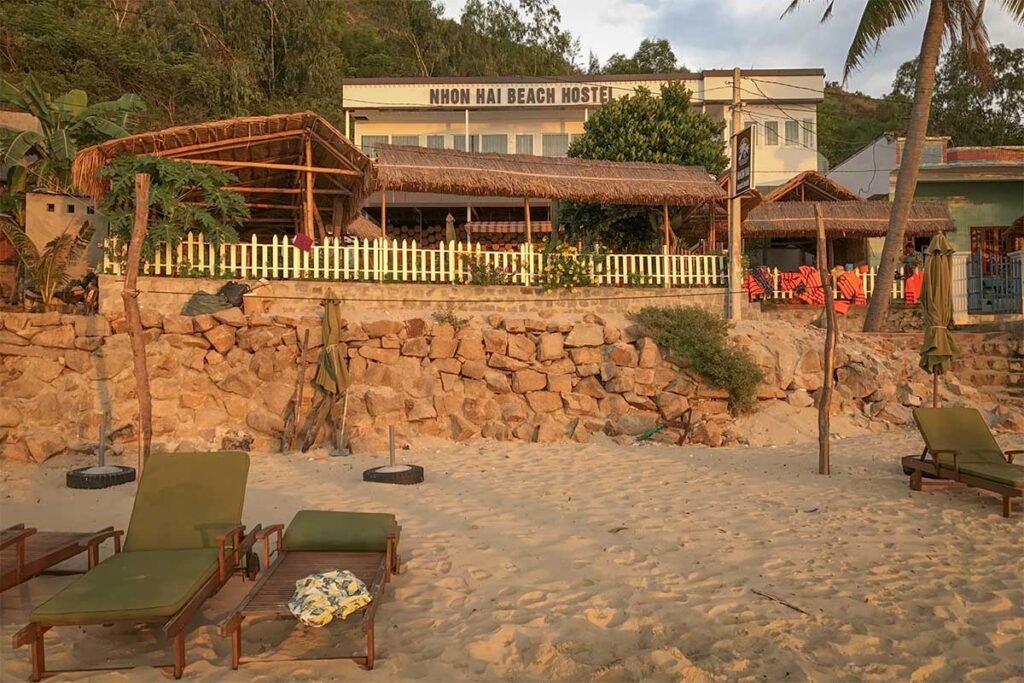
Set right on the sand, these small family-run places offer basic but comfortable rooms, some with balconies facing the sea. The atmosphere is informal and friendly, with owners often helping arrange boats or lending snorkel gear. Ideal if you want to wake up to the sound of waves rather than traffic.
Budget guesthouses on the main road
Just behind the beach, a few low-cost guesthouses provide clean rooms with fans or aircon at good value. They don’t have the same views as the beachfront spots, but you’re only steps from the sea and get a more local neighborhood feel.
Beach camping / tents (limited)
In some areas, properties rent out tents on the sand or allow camping for a small fee. It’s a fun idea if you want a closer-to-nature experience, but don’t expect full facilities—showers and toilets are usually only available if you eat or stay at the hosting place. Always check first where camping is permitted.
Food & facilities
Restaurants & stalls
Eating in Nhon Hai is straightforward—think small seafood restaurants and family kitchens rather than formal dining. Menus are usually limited to what was caught that morning: fish, shrimp, clams, and squid, cooked simply by grilling, steaming, or frying. Prices are fair, but don’t expect printed menus or English translations; pointing and a smile usually work fine. Always bring cash, as cards are not accepted.
Signature bites
The local specialty is banh xeo muc, crispy rice pancakes filled with squid. They’re typically cooked in small pans along the roadside or near the beach, with vendors serving them fresh from the pan in the late afternoon or evening. The squid is often cooked with its ink, which adds a briny flavor—worth trying if you’re adventurous. It’s one of the most distinctive dishes of Nhon Hai and a good reason to linger until mealtime.
Showers, toilets & day facilities
If you’re just visiting for the day, facilities are limited. Some beachfront spots like CocoCamp offer showers and toilets for paying customers, which makes them a convenient base for snorkeling or swimming. Don’t expect modern beach clubs—these are simple setups, but handy if you want to freshen up before heading back to Quy Nhon.


Shops & ATMs
There are no convenience store chains or ATMs in Nhon Hai. Instead, a few small household shops sell basic drinks, ice, and snacks. Bring enough cash for food, boat rides, or any extras, as you won’t be able to rely on card payments. If you need an ATM, you’ll find one back in Quy Nhon city.
Practical visiting information & tips
Best time to visit
The best conditions at Nhon Hai are from March to September, when the sea is generally calm and skies are clear. Visibility for snorkeling is often best in late spring and summer. In some months, you may also see green moss or golden seaweed on the coastal rocks, which makes the scenery extra photogenic. The rainy season (roughly October–February) can bring rougher seas and less predictable weather.

What to bring
Pack for a low-service beach day. Reef-safe sunscreen and a hat are important since there’s little natural shade. Bring enough drinking water and cash, as card payments aren’t common. If you’re particular about snorkel fit, bring your own mask and fins. A dry bag is useful for boat trips to Hon Kho, and a light jacket can help with the wind on motorbike rides.
Managing expectations
Nhon Hai is a real fishing village first and a tourist spot second. Facilities are simple, you may see some beach litter, and boat sellers can be persistent. A polite “no, thank you” usually works. Compared with Ky Co, the beach is far less crowded, which many people prefer.
Combine your visit on the Phuong Mai Peninsula
A trip to Nhon Hai fits well into a broader day exploring the peninsula. Highlights include:
- Eo Gio – dramatic cliffs and sea views
- Ky Co Beach – famous white-sand beach with tour facilities
- Phuong Mai sand dunes – striking desert-like scenery near the coast
This makes Nhon Hai a flexible half-day stop or part of a longer peninsula circuit.
Is Nhon Hai worth visiting?
Nhon Hai is well worth a half-day or even a slow overnight if you like quiet beaches and local village life. The beach is clean, swimmable, and less crowded than Ky Co, and the easy hop to Hon Kho adds variety with coral snorkeling and views. That said, it’s not a resort area—there’s no nightlife, limited restaurants, and only simple facilities. If you set expectations for a low-key, local experience, it’s a rewarding stop.
